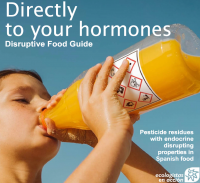Today, PAN Europe's Spanish member Ecologistas en Acción presented its report "Directly to your hormones. A disruptive food guide" (Original title: Directo a tus hormonas Guia de de alimentos disruptores). The report analyses the food pesticide residue data that the Spanish Agency for Food Safety and Nutrition (AESAN) published this year based on the data delivered for the EU pesticide residue monitoring programme in food for Spain, for 2018.
The objective of the report is to offer to the population transparent and quality information about the food products that are being consumed in Spain, as well as to highlight the available alternatives for safer food production and demand that all public administrations take more ambitious measures to protect people's health.
Main findings:
- 137 different pesticides were detected in food sold in Spain
- 39% correspond to pesticides that are not currently authorised
- Fruit and vegetables are the group where the highest number of pesticide residues (118 pesticides in total)
- Up to 41 pesticides were detected in grapes, one apple sample can contain 31 pesticides!
- Between 37 to 72 of these pesticides are endocrine disruptors (EDCs), that may cause adverse health effects to humans particularly during early life, at low exposures. Therefore, it is the most vulnerable group of our population, babies and children, that we're putting at risk!
There is an urgent need to transform the unsustainable industrial system of food production to one based on the principles of agro-ecology. The report provides recommendations how to make this possible.
For more details and access to the report in Spanish please visit Ecologistas en Acción website.
Follow this link for an english summary.
